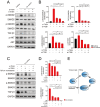TNS4 promotes lymph node metastasis of gastric cancer by interacting with integrin Β1 and inducing the activation of fibroblastic reticular cell
- PMID: 40481538
- PMCID: PMC12144749
- DOI: 10.1186/s12935-025-03830-x
TNS4 promotes lymph node metastasis of gastric cancer by interacting with integrin Β1 and inducing the activation of fibroblastic reticular cell
Abstract
Lymph node (LN) metastasis of gastric cancer (GC) is one of the important pathways of GC metastasis, indicating the clinical staging and prognosis of patients. To investigate the underlying mechanism during the process of GC-induced LN metastasis, 7 pairs of GC tissues, paracancerous (PC) tissues, GC-positive LN (LN.P) and GC-negative LN (LN.N) tissues from GC patients with homogeneity were selected for RNA sequencing (RNA-seq) analysis. Tensin 4 (TNS4) was screened out and found to be significantly upregulated in LN.P tissues and closely related with the characteristics of GC. In vitro and in vivo experiments demonstrated that knockdown of TNS4 could significantly inhibit LN metastasis of GC cells and activation of fibroblastic reticular cells (FRCs) in LNs, thus inhibiting LN expansion induced by tumor cell invasion. Moreover, TNS4 was found to be interacted with integrin beta 1 (ITGB1) on FRCs, thereby affecting the binding of transforming growth factor β1 (TGF-β1) to ITGB1 and subsequently regulating downstream signaling molecules, and supporting the GC cell-induced LN metastasis.
Keywords: Fibroblastic reticular cells; Gastric cancer; Integrin beta 1; Lymph node metastasis; Tensin 4.
© 2025. The Author(s).
Conflict of interest statement
Declarations. Ethics approval and consent to participate: The study was approved by the Research Ethics Committee of Renji Hospital, School of Medicine, Shanghai Jiao Tong University. All participants in the study provided informed consent before specimens were collected. Approval letter of Shanghai Jiaotong University School of Medicine, Renji Hospital Ethics Committee is KY2024-046-C. The animal experiments were approved by the Renji Hospital Animal Ethics Committee (ID: 2024-066). Competing interests: The authors declare no competing interests.
Figures






References
-
- Siegel RL, Miller KD, Jemal A. Cancer statistics, 2020. Ca-a Cancer J Clin. 2020;70:7–30. - PubMed
-
- Zeng YJ, Jin RU. Molecular pathogenesis, targeted therapies, and future perspectives for gastric cancer. Sem Cancer Biol. 2022;86:566–82. - PubMed
-
- Wang YY, Zhou YQ, Xie JX, et al. MAOA suppresses the growth of gastric cancer by interacting with NDRG1 and regulating the Warburg effect through the PI3K/AKT/mTOR pathway. Cell Oncol. 2023;46:1429–44. - PubMed
Grants and funding
LinkOut - more resources
Full Text Sources
Miscellaneous

